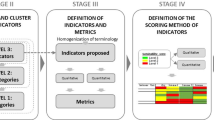Abstract
Both the Aalborg Commitments and the guidance on integrated urban environmental management and sustainable urban transport plans proposed by the EU Thematic Strategy on the Urban Environment foresee a baseline review as the first step in developing integrated urban management plans and systems. A baseline review of urban sustainability undertaken in Riga reveals significant discrepencies between the sustainability criteria of the Aalborg Commitments and the: responsibilities and competencies of the municipal government and administration as defined by statutes; policy goals and measures defined in municipal planning documents; policy goals and measures defined in the Riga Development Plan. To better orient the mandate of the municipality towards sustainable development, municipal statutes should be supplemented to more fully reflect the issues defined by the Aalborg Commitments and should include sustainability as a goal. In order to strengthen the implementation of sustainable development specific policy goals, measures and targets should be formulated for all the Aalborg Commitments issues when revising existing municipal planning documents or developing a municipal sustainable development management plan. An analysis of the European Common Indicators and the State of the Environment in Riga 2001 indicators indicates that they can only partially fulfill a monitoring function for the implementation of the Aalborg Commitments. This highlights a need to better coordinate sustainable development initiatives at the European level. The methodology used for the baseline review in Riga is useful for assessing the status of urban sustainability when preparing integrated urban management plans or systems, but requires testing elsewhere.







Similar content being viewed by others
References
ACTOR —Aalborg Commitments Tools and Resources. (2006). EU Sixth Framework Programme funded policy-oriented research project, http://www.actor.sustainable-cities.org.uk/index.html.
Cabinet of Ministers of the Republic of Latvia. (2002). Strategy for sustainable development of Latvia, 32 pp.
COM 718 final. (2005). Communication from the Commission to the Council and the European Parliament on Thematic Strategy on the Urban Environment.
COM 0037. (2005). The review of the EU Sustainable Development Strategy: Initial stocktaking and future orientations.
COM 60 final. (2004). Communication from the Commission to the Council, the European Parliament, the European Economic and Social Committee and the Committee of the Regions, Towards a Thematic Strategy on the Urban Environment, Brussels, 11.02.2004.
COM 218 final. (1990). Green Paper on the urban environment.
COM 264 final. (2001). Communication from the Commission. A sustainable Europe for a better world. A European Union Strategy for sustainable development, Commission of the European Communities, Brussels, 15.05.2001.
Council of the European Union. (2006). Renewed EU sustainable development strategy.
Daly, H. E. (1991). Steady state economics. Washington: Covelo.
European Commission. (2002) Decision No 1600/2002/EC of the European Parliament and of the Council of 22 July 2002 laying down the Sixth Community Environment Action Programme.
ICLEI —International Council for Local Environmental Initiatives. (1994). Charter of European cities and towns towards sustainability, ICLEI European Conference on Sustainable Cities and Towns, Aalborg, Denmark, 24–27 May 1994.
ICLEI —International Council for Local Environmental Initiatives: 2004, Aalborg Commitments, http://www.aalborgplus10.dk/.
ICLEI —International Council for Local Environmental Initiatives and The International Development Research Centre. (1996). The local agenda 21 planning guide, an introduction to sustainable development planning.
MEPRD. (2002). Ministry of environmental protection and regional development: Latvian National Report “Rio + 10” to the World Summit on Sustainable Development in Johannesburg, Riga, 2002.
Riga City Council and University of Latvia. (2005). Sustainability of development in Riga: opportunities and challenges, Riga City Council, Riga City Environment Centre Agenda 21 and University of Latvia, Faculty of Geography and Earth Sciences, 67 pp (in Latvian).
Riga City Environment Centre Agenda 21. (2001). State of the Environment in Riga 2001 (CEROI), (http://www.ceroi.net/reports/riga/latviski/lvl_index.htm).
Spangenberg, J. H. (2001). Investing in sustainable development, the reproduction of man made, human, natural and social capital. International Journal of Sustainable Development, 4(2), 184–201.
Spangenberg, J. H. (2005). Economic sustainability of the economy: Concepts and indicators. International Journal of Sustainable Development, 8(1/2), 47–64.
Spangenberg, J. H. (2006). The Economic sustainability of the economy—Assessing the Sustainability of a Complex System by Applying Orientor Theory. In W. Leal Filho, A. Ubelis, & D. Bērzina (Eds.), Sustainable development in the baltic and beyond (pp. 25–41). Peter Lang. .
UN. (1993). Report of the United Nations Conference on Environment and Development, Rio de Janeiro, 3.-14. June 1992, Vol. 1: Resolutions Adopted by the Conference; Vol. 2: Documents adopted by the Conference, United Nations, New York.
UNCED (1993). Agenda 21: Program of action for sustainable development. New York: United Nations Department of Public Information.
UNCSD (1996). Indicators of sustainable development, framework and methodologies. New York: United Nations.
World Commission on Environment and Development (1987). Our common future. London, UK: Oxford University Press.
Author information
Authors and Affiliations
Corresponding author
Additional information
Readers should send their comments on this paper to BhaskarNath@aol.com within 3 months of publication of this issue.
Rights and permissions
About this article
Cite this article
Zilans, A., Abolina, K. A methodology for assessing urban sustainability: Aalborg commitments baseline review for Riga, Latvia. Environ Dev Sustain 11, 85–114 (2009). https://doi.org/10.1007/s10668-007-9099-y
Received:
Accepted:
Published:
Issue Date:
DOI: https://doi.org/10.1007/s10668-007-9099-y




